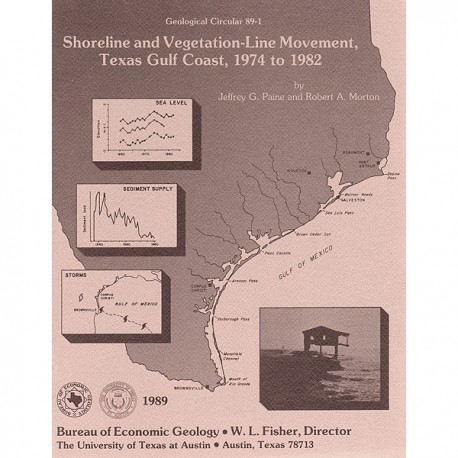Geological Circulars
-
Books & Reports
- Reports of Investigations
- Guidebooks
- Udden Series
- Geological Circulars
- Down To Earth
- Atlases of Major Oil and Gas Reservoirs
- Texas Memorial Museum Publications
- Environmental Geologic Atlas of the Texas Coastal Zone
- Mineral Resource Circulars
- Other Reports
- Seminars and Workshops
- Handbooks
- Submerged Lands of Texas
- Symposia
- Annual Reports
- Open File Reports
-
Maps & Cross Sections
- Thematic Maps
- Miscellaneous Maps, Charts & Sections
- Geologic Atlas of Texas
- STATEMAP Project Maps
- Geologic Quadrangle Maps
- Cross Sections
- Highway Geology Map
- Energy and Mineral Resource Maps
- Shoreline Change and Other Posters
- Wilcox Group, East Texas, Geological / Hydrological Folios
- Bouguer Gravity Atlas of Texas
- River Basin Regional Studies
- Featured Maps
- Posters
- Teachers & the Public
-
Geological Society Publications
- Gulf Coast Association of Geological Societies
- Alabama Geological Society
- Austin Geological Society
- Corpus Christi Geological Society
- Houston Geological Society
- Lafayette Geological Society
- Mississippi Geological Society
- New Orleans Geological Society
- South Texas Geological Society
- GCS SEPM Publications
- Historic BEG & UT Series
Shoreline and Vegetation-Line Movement, Texas Gulf Coast, 1974 to 1982
GC8901
Shoreline and Vegetation-Line Movement, Texas Gulf Coast, 1974 to 1982, by J. G. Paine and R. A. Morton. 50 p., 15 figs., 5 tables, 3 appendices, 1989. ISSN: 0082-3309. Print Version.
For a downloadable, digital version: GC8901D.
GC8901. Shoreline and Vegetation-Line Movement, Texas Gulf Coast, 1974 to 1982, by J. G. Paine and R. A. Morton. 50 p., 15 figs., 5 tables, 3 appendices, 1989. ISSN: 0082-3309. Print.
To purchase this publication as a PDF download, please order GC8901D.
ABSTRACT
The purposes of this study were (1) to quantify recent (1974 to 1982) movement of Texas shorelines and vegetation lines by analysis of aerial photographs; (2) to place this movement in historical (pre-1974) context; and (3) to examine the influence of environmental variables such as storms, sea level, subsidence, and sediment supply on the movement of coastal boundaries.
Shorelines and vegetation lines predominantly retreated between 1974 and 1982, a period of few tropical cyclones, relative sea-level stability, average fluvial discharge, and average rainfall. Shorelines retreated at 44.5 percent of 373 sites at an average rate of 0.9 ft/yr, whereas vegetation lines retreated at 56.1 percent of 319 sites at an average rate of 5.5 ft/yr. Between 1974 and 1982, approximately 330 acres of Gulf beach was eroded, and vegetation was removed from about 2,000 acres of beach. Erosion was most rapid at the Brazos-Colorado and Rio Grande fluvial-deltaic headlands and along south Padre Island.
The most significant geological event affecting the Texas coast between 1974 and 1982 was Hurricane Allen, which made landfall north of Brownsville in 1980. Relatively little net shoreline movement during the study period indicates that Texas shorelines had generally recovered from this storm by 1982. Net vegetation retreat on the upper Texas coast increased southward from an average of 25 ft between Sabine Pass and Bolivar Roads to 90 ft on Matagorda Peninsula. This net loss, primarily due to Hurricane Allen, indicates that little recovery of the vegetation line occurred during the first two years after the storm. Relatively low net vegetation-line retreat on the middle Texas coast implies that retreat caused by Allen (up to 100 ft in this area) countered vegetation-line advance between 1974 and Allen landfall. The pre-Allen advance probably represents a combination of (1) normal vegetation-line advance in an area of adequate sediment supply and (2) vegetation recovery from Hurricane Celia, which crossed the middleTexas coast in 1970.
Between 1974 and 1982, the Texas Gulf shoreline retreated slowly as a result of low storm incidence and relative sea-level stability. Erosion rates after 1982 will probably be higher, possibly approaching levels of the mid-1960's to mid-1970's, because of landfall of hurricanes such as Alicia in 1983 and increasing rates of relative sea-level rise since 1982. Continued reduction of sediment supply and construction and maintenance of reservoirs, jetties, and navigation channels will also contribute to higher erosion rates.
Keywords: barrier islands, coastal processes, geologic hazards, Hurricane Allen, shoreline changes, Texas, Texas Coastal Zone, vegetation-line changes
Citation
Paine, J. G., and Morton, R. A., 1989, Shoreline and Vegetation-Line Movement, Texas Gulf Coast, 1974 to 1982: The University of Texas at Austin, Bureau of Economic Geology, Geological Circular 89-1, 50 p.


